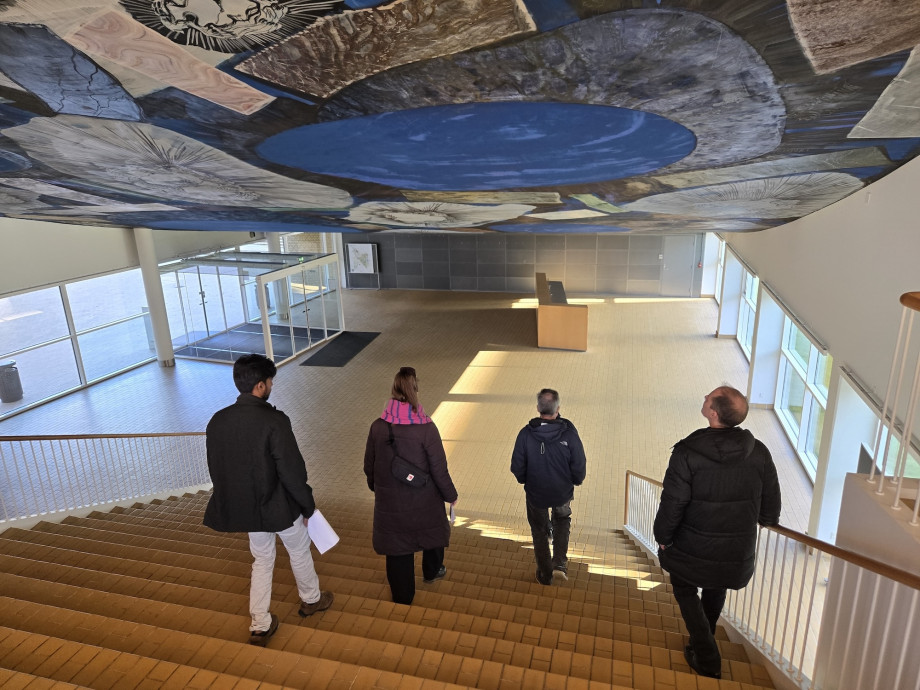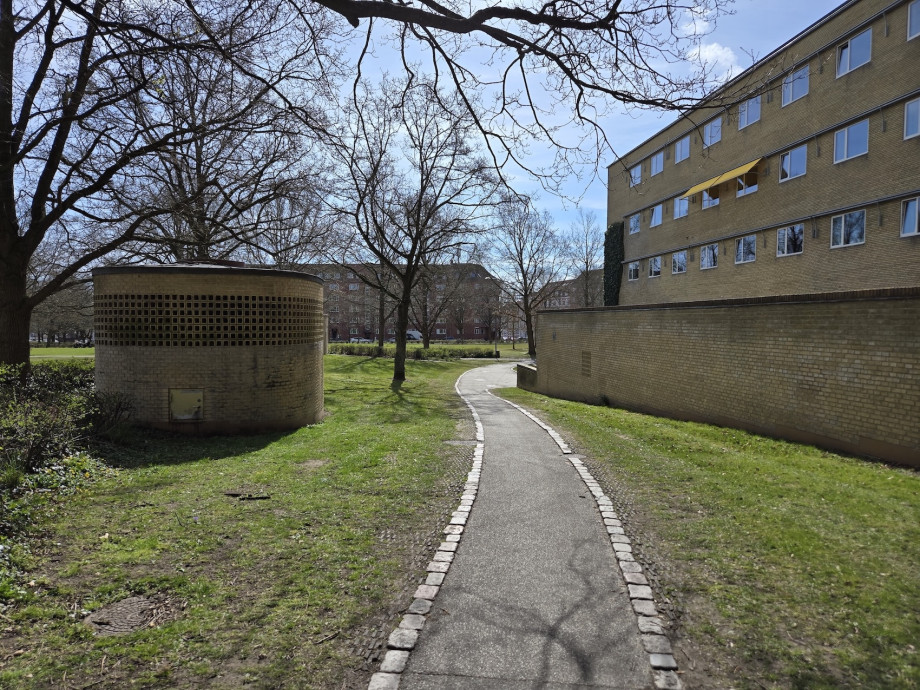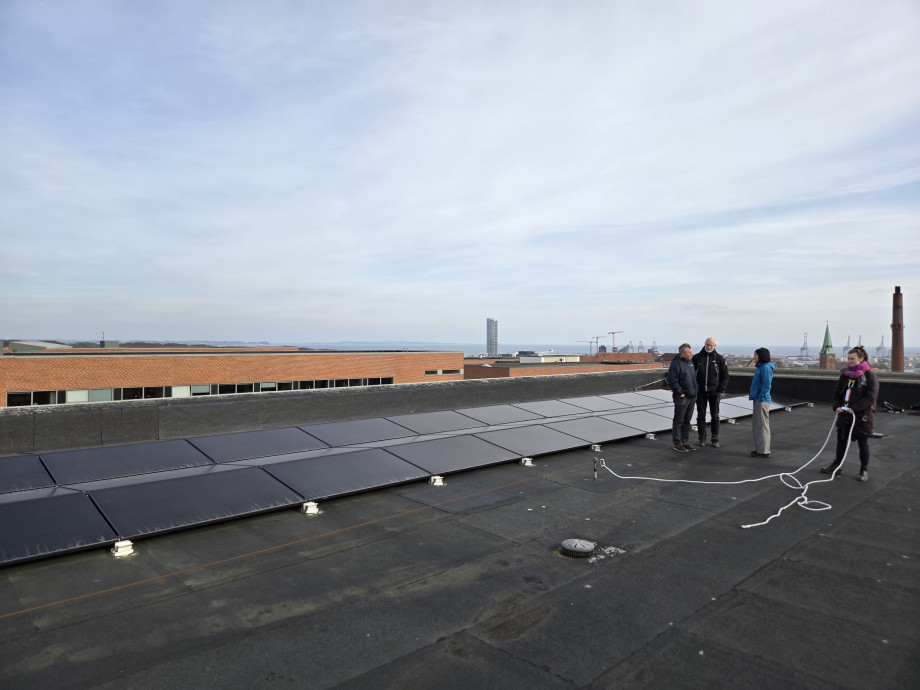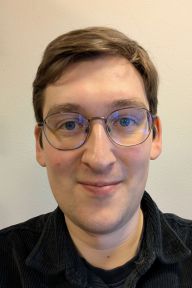This is the third and final blog post about the Infrastructural Citizen Week 2025, which was organised by the Energy Lives! project in Gothenburg, Stavanger and Aarhus from 24-28 March 2025. In Aarhus, the project team invited to a guided energy walk across university campus, through its underground and over its rooftops. Bue Juul Poulsgaard reflects on transitions between spaces and energy systems.
Blogginnlegg
Blogginnlegget er skrevet av
We met up at Søauditoriet for a guided energy walk to sense – hear, see, smell and touch – places of energy and sustainable transitions at Aarhus University Campus as part of the Infrastructural Citizen Week. The campus buildings at Aarhus date back to 1931. An assemblage of several buildings, they are all characteristically constructed from yellow bricks with yellow tile as roofing, located on the hillsides and slopes surrounding a lake. In the heart of it, just by the lakeside, you find Søauditoriet, where the beauty of the surroundings is also drawn inside through the huge wall paintings - “Anastasis” - by the Danish artist Per Kirkeby covering 500 square metres. It is here our guide Hans Buhl from the Steno Museum started the tour by leading us through the building’s halls, priming our attention to sense the unseen – the infrastructures of energy. As we stood beneath some of these mural paintings, trying to grasp its scale, Hans told us about how almost 40% of the total energy consumption in Denmark takes place in buildings: light, ventilation, general electricity use – cooking, television and other appliances. On top of that comes cooling in the summer and heating in the winter.

Throughout the walk, participants were asked to give responses or sensory impressions in relation to something seen, heard or experienced. Most of the associations to energy can be divided into consumption: heat, fire, light, caffeine and kilowatt and the feeling or output that comes from consumption of energy: life, warm, climate and growth. For us, then, energy was synonymous with work; an association we were to challenge on this walk.

On our way across campus, we passed by several small buildings, commonly ignored by passersby – neither I had given them much attention previously. At some point a participant stopped and remarked: “It looks to be a storage facility of some sort”. Hans Buhl then directed our attention towards the trees above it. “The leaves are always in motion, despite there not being any wind. Can you guess why?” No one answers. “At the top you find the exhaust, and if you try holding a hand close to the holes in the side you will feel the air being sucked in. That is the intake. This is a cooling tower for a supercomputer capable of doing very elaborate, complex and accurate calculations that draws about as much power as a couple hundred Danish households per year.” Puts things into perspective. Energy and infrastructures of energy is often not seen or heard, and even if, as this building obviously can be seen and heard, it is not paid attention to. But if you are open to sense then you might just sense the unseen.
“Is the hot air just being blown out the top and not used?” one asked. But Hans Buhl explained that “the excess heat is not warm enough to be used in the district heating system. And to bring the temperature up by other means is too expensive compared to just letting the air out.”
Video of the branches above the cooling tower moving from the air being exhausted and spider webs moving from the air in-takes. Video by Bue Juul Poulsgaard.
After going through hallways, doors, and down several stairs passing many triangular signs warning about momentarily high radiation levels – leaving behind one participant due to fear of radiation – we passed through a big yellow door into a big room with tubes upon tubes upon tubes with wires and aluminium foil all over. In this room there are computer screens everywhere and concrete blocks stacked high upon each other. In the middle of it all a ring of a tube – ASTRID2, AU’s synchrotron radiation source, capable of creating a special light by bringing particles up to almost light speed. A very energy intensive task. ASTRID2 resides just beneath a parking lot, with no indication of what lies beneath apart from some of the anonymous cooling towers. And standing in the middle of ASTRID2 there were also no sensory impression of the device’s feat of speed and energy hunger, apart from the faint feeling of heat from the coil on one of the many powerful electromagnets, from the last cycle or particles earlier that day.

After visiting ASTRID2 the participants wrote down some sensory impressions:
“Noise from instruments, visual confusion/saturation, basement smell.”
“Smell of metal and electronics, hot air, dimmed lights.”
Everywhere in this place there was the characteristic smell of basement, the feeling of hot air and the faint noise from instruments. All was grey in colour and this coupled with the dimmed lights made everything blend visually. The visit at ASTRID2 could not be further apart from our visit to the roofs of Nobelparken the next day. Here atop a five-story high building we were to see one of society’s many silent but tireless workers. Shiny and dark blue, almost black in colour, the solar panels produce sustainable electricity.
“Danish law does not allow institutions such as AU to be a producer and distributor of electricity. As a part of the EU financed AURORA project, we then set out to investigate and facilitate consumer driven sustainable change.” Zhe Zhang explained – our guide at the rooftop and one of the key persons behind the construction of the solar panels. Zhe then proceeded to talk about how the solar panels are the property of an energy community, consisting of students and staff at AU. For almost a year they have been producing just about 16.000 kWh of power and are predicted to have paid for themselves after twenty years.
We talked about how such a project perhaps could spearhead change, as it showcases that an energy community such as this is possible and that the rooftops of the cities are in fact a very good resource in transitioning society to be more sustainable. “A key aspect is always cost, and it might not even be that costly as people are more than willing to participate,” Zhe elaborated. The cost of a share ranged from 800-1000kr. with a total of around 900 shares – all sold.

I and a colleague talk about how beautiful the view is from here. “It is almost poetic. The more the sun shines, the more refreshed we feel and the more sustainable energy we have.” I wonder if one answer to the transition towards more sustainable energy production and consumption can be as simple as that. The solar panels at Nobelparken certainly gave this impression.
